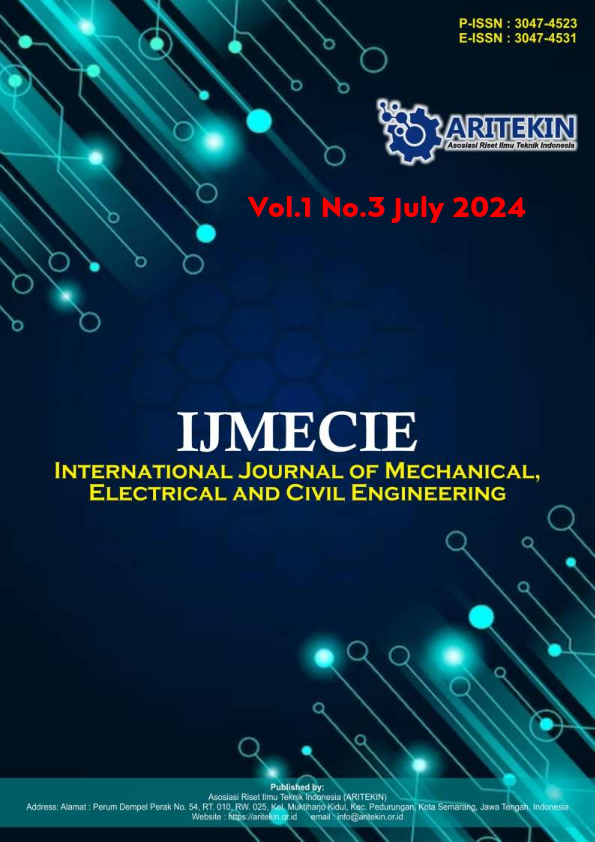Analysis of Physical Fitness Levels of High School Students Using the Indonesian Student Fitness Test Application (TKPN)
DOI:
https://doi.org/10.61132/ijmecie.v1i3.16Keywords:
Physical Fitness, Physical Education, TKPN (Indonesian Student Fitness Test)Abstract
Physical fitness is a person's ability to do something or a task well without excessive fatigue and can be useful in developing students' learning and insight. Apart from that, physical fitness is also important in learning, especially in learning PJOK. However, many people consider physical fitness unimportant. The aim of this research is to determine the level of physical fitness of students and the differences in physical fitness levels of vocational science and vocational social science at SMA Hang Tuah 5 Sidoarjo. This research involved class XI F2 and class XI F5. Class XI F2 has 33 students with a ratio of 17 male students and 16 female students. Class XI F5 has 36 students with a ratio of 19 male students and 17 female students. This research applies a non-experimental method with a comparative design using the Independent sample t-test data analysis technique. The TKPN test (Indonesian Student Fitness Test) was used as an instrument for this research. The results obtained from the SPSS application showed a hypothesis test value of 0.15 (p-value > 0.05), indicating that there was no difference in physical fitness. Meanwhile, from the norm results for fitness results in the TKPN test (Indonesian Student Fitness Test) there was a difference in scores of 4.47 for science vocational students in the very good category and 3.78 social science vocational students in the good category.
References
Bagaskoro, FTRI, Jasmani, P., Health, O., Recreation, DAN, Sports, FI, & Semarang, UN (2020). Banjarnegara Regency in 2019.
Baresi, MR, Permadi, AA, & Hermawan, I. (2023). The influence of physical activity on the physical fitness of the VIII/Tarumanagara battalion student regiment. Bima Loka: Journal of Physical Education, 2(2), 71–79. https://doi.org/10.26740/bimaloka.v2i2.21365
Bergier, J., Tsos, A., Popovych, D., Bergier, B., Niźnikowska, E., Ács, P., Junger, J., & Salonna, F. (2018). Level of and factors determining physical activity in students in Ukraine and the visegrad countries. International Journal of Environmental Research and Public Health, 15(8), 1–12. https://doi.org/10.3390/ijerph15081738
Destriana, D., Aryanti, S., Destriani, D., Syamsuramel, S., Ramadhan, A., Nanda, FA, & Lestari, R. (2023). Assistance and Technical Guidance for Indonesian Student Fitness Tests for PJOK Teachers in Lahat Regency. Journal of National Community Service, 1(9), 1960–1968. https://doi.org/10.59837/jpmba.v1i9.451
Fajaryanto, M., Herpandika, RP, & Pratama, BA (2022). SPRINTER: Journal of Sports Science Results of the Application of TKPN to Students at SDN 1 Rejomulyo, Kras District, Kediri Regency. 3(3), 223–229.
Gu, X., Chang, M., & Solmon, M. A. (2016). Physical Activity, Physical Fitness, and Health-Related Quality of Life in School-Aged Children. 117–126.
Jananto, FA, & Warthadi, AN (2023). Analysis of Physical Fitness Levels of Muhammadiyah 1 Sukoharjo Vocational High School Students. Jambura Journal of Sports Coaching, 5(2), 149–154. https://doi.org/10.37311/jjsc.v5i2.20890
Kljajević, V., Stanković, M., Ðorđević, D., Trkulja-Petković, D., Jovanović, R., Plazibat, K., Oršolić, M., Čurić, M., & Sporiš, G. (2022) . Physical activity and physical fitness among university students—A systematic review. International Journal of Environmental Research and Public Health, 19(1). https://doi.org/10.3390/ijerph19010158
Kristiyandaru, A., Christina, S., Wibowo, S., Wahyudi, H., Ashadi, K., Himawan, I., Ridwan, M., Wijaya, A., Fitroni, H., Prakoso, BB, Ardha , MA Al, & Sifaq, A. (2020). Physical Education: Realizing the Meaning of My Life (1st ed.). Zifatama Jawara.
Kusyandi, A., Murniviyanti, L., & Rizhardi, R. (2021). Differences in Students' Physical Fitness Levels. Jolma, 1(1), 1. https://doi.org/10.31851/jolma.v1i1.5365
Nusantara, P., Sma, P., & Tahun, NP (2023). Survey of physical fitness through fitness tests for Indonesian students at SMA N 1 Plupuh in 2023. 23(2), 13–22.
Rahman, A., Munandar, SA, Fitriani, A., Karlina, Y., & Yumriani. (2022). Understanding Education, Educational Sciences and Elements of Education. Al Urwatul Wutsqa: Islamic Education Studies, 2(1), 1–8.
Rusdiana, A., Wiriawan, O., Ronald, H., Hadi, D., Guntur, P., Komarudin, P., Darmadi, D., Al Ardha, MA, Wicaksono, A., Fitranto, N., Nurulfa, R., Rochmani, KW, Taufik, M., & Zamil, A. (2022). Guidelines for Implementing Indonesian Student Fitness Tests.
Setyawan, AW, & Wahyuni, Endang S. (2018). Survey of Physical Fitness Levels of Students at SMP Negeri 1 Sampang. Journal of Sports and Health Education, 6(2), 351–353.
W, Y., Ali, R. ., Triansyah, A., Haetami, M., Hidasari, F. ., Simanjuntak, VG, Atiq, A., Bafadal8, M. ., Suwanto, W., & Pranata, D. (2024). PEDAMAS Journal (Community Service) Volume 2, Number 1, January 2024 ISSN: 2986-7819 Introduction Physical fitness in schools can be achieved optimally through. 2(1), 183–187. https://ojs.berajah.com/index.php/go/article/view/128
Downloads
Published
How to Cite
Issue
Section
License
Copyright (c) 2024 International Journal of Mechanical, Electrical and Civil Engineering

This work is licensed under a Creative Commons Attribution-ShareAlike 4.0 International License.





